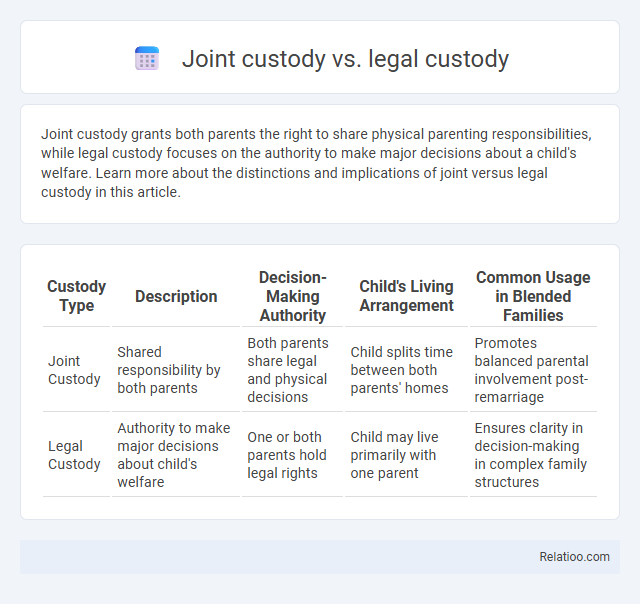Joint custody grants both parents the right to share physical parenting responsibilities, while legal custody focuses on the authority to make major decisions about a child's welfare. Learn more about the distinctions and implications of joint versus legal custody in this article.
Table of Comparison
| Custody Type | Description | Decision-Making Authority | Child's Living Arrangement | Common Usage in Blended Families |
|---|---|---|---|---|
| Joint Custody | Shared responsibility by both parents | Both parents share legal and physical decisions | Child splits time between both parents' homes | Promotes balanced parental involvement post-remarriage |
| Legal Custody | Authority to make major decisions about child's welfare | One or both parents hold legal rights | Child may live primarily with one parent | Ensures clarity in decision-making in complex family structures |
Understanding Joint Custody
Understanding joint custody involves recognizing it as an arrangement where both parents share legal and/or physical responsibilities for their child. Joint legal custody means both parents have equal rights to make important decisions about the child's upbringing, education, and health, whereas joint physical custody focuses on sharing the child's living time. Your custody agreement can include one or both types of joint custody, balancing parental involvement and the child's best interests.
What is Legal Custody?
Legal custody refers to the authoritative right to make important decisions about a child's upbringing, such as education, healthcare, and religious instruction. Unlike joint custody, which involves shared physical or legal responsibilities between parents, legal custody specifically addresses decision-making power rather than day-to-day care. Understanding your legal custody rights is essential for ensuring your child's best interests are maintained in family law arrangements.
Key Differences Between Joint and Legal Custody
Joint custody refers to both parents sharing physical and/or legal rights, whereas legal custody specifically involves decision-making authority regarding a child's welfare. The key difference between joint and legal custody lies in control: joint custody often includes shared physical time and responsibilities, while legal custody centers on rights to make important decisions about education, healthcare, and religion. Understanding these distinctions helps you navigate custody arrangements tailored to your child's best interests.
Advantages of Joint Custody
Joint custody combines both legal and physical custody, allowing parents to share decision-making responsibilities and parenting time, promoting balanced child involvement from both sides. This arrangement supports the child's emotional well-being by fostering stable relationships with both parents and reduces the potential for parental conflict through cooperative co-parenting. Joint custody also ensures ongoing participation in important aspects of the child's education, healthcare, and extracurricular activities, contributing to more comprehensive child development.
Benefits of Legal Custody
Legal custody grants parents the authority to make critical decisions regarding their child's education, healthcare, and welfare, ensuring both parents have a say in significant aspects of the child's life. Unlike joint custody, which involves shared physical time and care, legal custody prioritizes decision-making responsibility, fostering cooperative parenting and reducing conflicts over important matters. The benefits of legal custody include clear authority in decision-making, promoting stability and consistency in the child's upbringing, while enabling both parents to remain actively involved in shaping the child's future.
Factors Courts Consider in Custody Decisions
Courts consider factors such as the child's best interests, including emotional bonds with each parent, the ability of each parent to provide stable and supportive environments, and the history of parental involvement when deciding between joint custody, legal custody, or sole custody arrangements. Joint custody typically involves shared physical and/or legal responsibilities, requiring cooperation between parents, while legal custody specifically refers to decision-making authority regarding the child's welfare, education, and healthcare. Judges weigh the parents' communication skills, willingness to cooperate, and the child's age and preferences to determine the most suitable custody arrangement.
Impact on Child’s Wellbeing
Joint custody, legal custody, and sole custody each impact a child's wellbeing differently based on the division of decision-making authority and physical time spent with parents. Joint custody, where both parents share physical and legal responsibilities, generally supports a child's emotional stability by fostering consistent relationships and collaborative parenting. Your child benefits most when custody arrangements prioritize open communication, minimal conflict, and a balanced environment promoting security and developmental growth.
Challenges of Each Custody Type
Joint custody often presents challenges in coordinating parental responsibilities and communication, potentially leading to conflicts over scheduling and decision-making. Legal custody disputes can arise when parents disagree on major decisions regarding education, healthcare, and religion, causing prolonged court battles and stress for all parties involved. Joint physical custody requires meticulous cooperation and flexibility to ensure children maintain stability and consistent routines between two households.
Modifying Custody Arrangements
Modifying custody arrangements typically requires a significant change in circumstances affecting the child's best interest, whether concerning joint custody, legal custody, or joint physical custody. Joint custody involves shared decision-making authority, while legal custody specifically refers to the right to make important decisions about the child's welfare, education, and health. Understanding how these types of custody differ helps you navigate the legal process when seeking adjustments to improve your child's living and care situation.
Tips for Co-Parenting Successfully
Effective co-parenting requires clear communication and mutual respect between parents sharing joint custody or legal custody arrangements to prioritize the child's well-being. You should establish consistent routines and boundaries while remaining flexible to accommodate your child's needs and developmental stages. Utilize mediation or counseling services when conflicts arise to maintain a cooperative and supportive environment for your child's growth.

Infographic: Joint custody vs Legal custody
 relatioo.com
relatioo.com